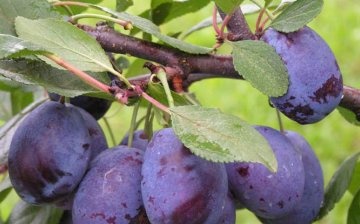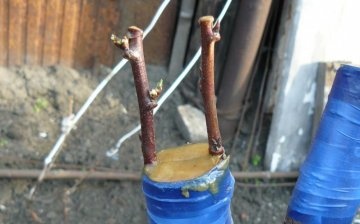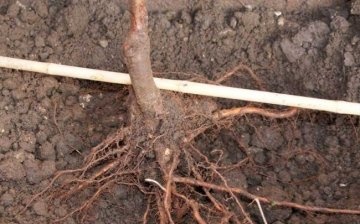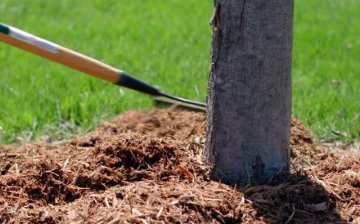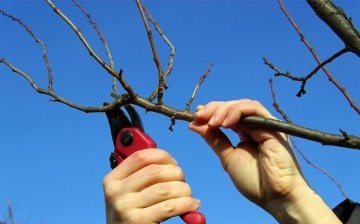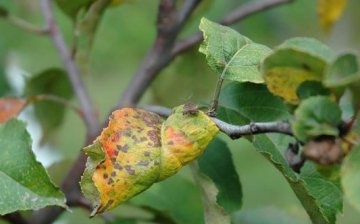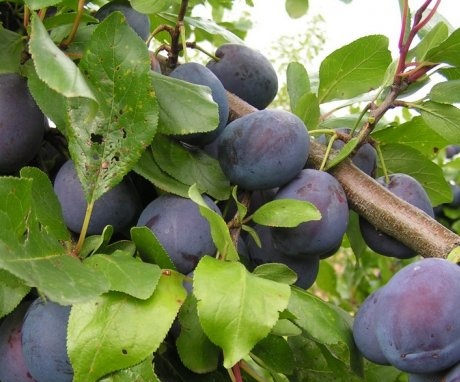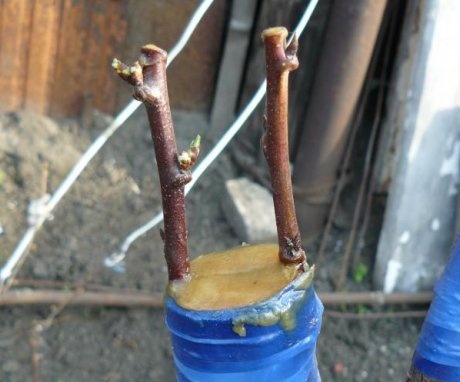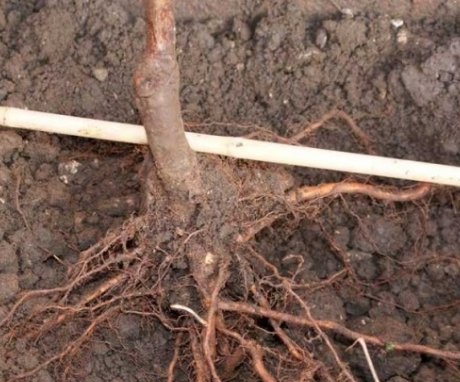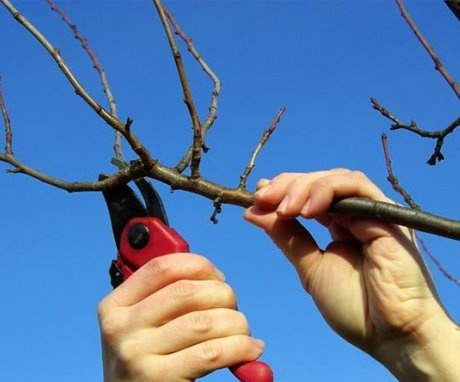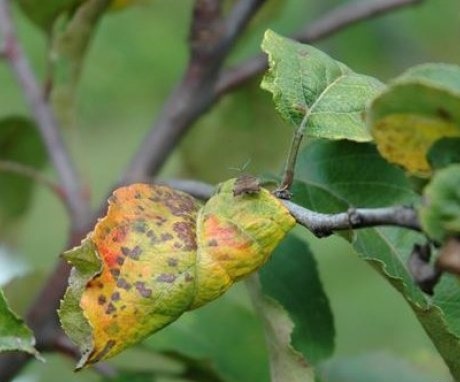Plum Volat: features of the variety and the rules for its cultivation
Volat plum is one of the most useful and vitamin-rich stone fruits known since ancient times. It is believed that the plum was formed in the course of experiments on pollination of cherry plum and blackthorn, and at the moment there are more than 200 varieties of species diversity. Ripe fruits are actively used in cooking, folk medicine and cosmetology.
Content:
- Characteristics of the variety
- Reproduction methods
- Terms and rules for planting a seedling
- Everything you need to know about feeding
- Pruning and preparing for winter
- Disease and pest control
Variety characteristic
Plum Volat belongs to self-fertile and frost-resistant varieties. Abundant fruiting begins within 4 years after planting and rooting of the seedling. The main difference of the variety is resistance to a number of diseases of garden fruit-bearing trees, as a result of selection work.
The height of an adult tree is 250 cm, flowering time is mid to late spring. Fruiting occurs in late summer and early autumn. It takes root in the climatic conditions of the Moscow region, the central zone of Russia, the northern and mountainous regions of Scandinavia.
Fruits on an adult tree are large, from 40 to 70 grams, the color is from dark blue to blue-blue, with a slight whiteness and a waxy layer.
The stone is 1/5 of the size of the fruit, it separates well from the pulp. The taste of plums is closer to sweet and sour varieties, they are used for dessert dishes and preservation.
Reproduction methods
The two main methods of propagation of the Volat plum are vegetative (grafting, planting green cuttings and propagation using root shoots) and sexual (seeds are used). Vaccination is considered the most effective of all methods. The varieties of frost-resistant plum, sometimes cherry plum or thorny plum, are used as a stock. Roots are used to maintain the purity of the variety and are taken from the best specimen of the species.
Features of seed propagation:
- For propagation by seeds, mature fruits are used, without damage, defects and diseases. The bones are removed, the remnants of the pulp are removed, washed under running water.
- Then they are subjected to soaking for a period of 3-4 days, every day the samples are mixed and filled with clean water. Then the collected seeds are dried and prepared for storage.
- The next stage is stratification... The seeds prepared for planting are mixed with a moisture-retaining substrate and kept at a temperature of + 1-10 ° C for 5-6 months.
- As soon as the planted seeds germinate, they are transferred to the cold, where they are kept until the spring heat.
In mid to late spring, the prepared seeds are ready for planting. By the fall, the samples obtained for the stock can be grafted to the selected varieties of plum or cherry plum.
Plum cuttings:
- For propagation by root cuttings, they are harvested in advance, in the fall. To do this, use the dug roots of a young tree, having previously measured at least one meter from the stem. The thickness of the root cuttings is approximately 1.5 cm, the length is no more than 15 cm. The prepared material can be stored in a cellar or buried to a depth of half a meter, insulated with peat and coarse sand on top.
- By the middle of spring, cuttings of Volat plum, cut into 10 cm pieces, are ready for planting in sandy-peat soil. Planting is carried out in an upright position or with a slight inclination, sprinkle with sand 4 cm from above. To accelerate rooting, a film is pulled from above to create greenhouse conditions.
- Important! At the current stage, drying out is detrimental to the shoots, so watering is done every day.
- During the season, the cuttings are fed with diluted humus or fertilizers with nitrogen, and with the onset of autumn they are insulated, falling asleep on top of sawdust or fallen tree leaves.
The next spring, the cuttings are prepared for planting. As a result, varietal seedlings of about 150 cm with a formed rhizome, ready for planting, are obtained.
Terms and rules for planting a seedling
Plum Volat gives a bountiful harvest on sod-podzolic, gray forest soil, black soil. The main condition is that the soil is sufficiently loose and of the same chemical composition. If the pH of the soil is less than 5.5, then lime is first scattered and dug up along with the soil at the place of planting at the rate of 0.5-0.8 kg per square meter.
It is possible to plant seedlings in the middle lane in the spring-autumn period - either before flowering in April or in the second half of September. A young tree should not be replanted after the leaves have opened, as this can lead to drying out.
The place in the garden is prepared at least 2 weeks before planting the tree.
The suitable hole depth is 0.4-0.5 meters, the diameter is 0.7 meters. A peg for a garter is dug into the center, and the bottom is filled with a nutrient mixture: humus, ammonium nitrate, superphosphate, potassium chloride, lime, coarse sand, a little rubble. After installing the seedling, straighten its roots and sprinkle it with black soil on top so as not to burn root system.
Suitable place for planting plums - an illuminated sunny area, protected from drafts. When planted next to tall fruit trees that create shade, the plum is placed on the south side.
Everything you need to know about feeding
To contribute organic fertilizers under the plum is recommended no more than three times a year. Fertilizers with phosphorus and potassium are best used in the autumn, after harvesting, and in the spring the tree needs more nutrient mixtures that increase the fertility of the soil, for example, fertilizers with nitrogenous bases.
You can feed plums in two ways:
- Application of mineral and organic fertilizers to the soil.
- Irrigation of a tree with liquid mineral-organic fertilizer.
To prepare a healthy and correct nutritional composition for plums yourself, several conditions must be met:
- Use as main component compost... Substances in its composition contribute to the decomposition of nitrogen to ammonium.
- Adding coffee grounds. Excellent as a solid and liquid fertilizer. It is advisable, after using it, to sprinkle the irrigation area with chopped plant waste.
- Using compost in combination with manure. High nitrogen content in the droppings of sheep, cows, pigs, chickens.
In the first year after the rooting of the seedling, the plum does not require special care. As soon as the tree begins to bear fruit, the dose of organic fertilizer should be increased at the rate of 10-15 kg per square meter. After adding fertilizer, the surface of the soil is dug up and loosened to a depth of about 20 cm.
Dolomite-lime mixture is used as a special feeding. This mineral fertilizer with a crystalline structure helps prevent the development of diseases on the plum and prevents the appearance of harmful insects.
Pruning and preparing for winter
It is better to prune plum trees in the second half of September so that the tree has time to fully prepare for wintering.Compliance with the rules of pruning contributes to the formation of the crown of the tree, in addition, too long and unkempt branches carry a potential danger - in case of strong winds or the adhesion of snow, the tree can break and die.
At the first pruning, the branches are shortened by a third of the height, shoots that grow quickly are cut by more than half. All dried and diseased branches are also removed, it is advisable to thin out the top of the plum as much as possible.
Plum care in autumn is aimed at preparing the tree for wintering. At the end of fruiting, the plum tree requires further care:
- Top dressing, including mineral and complex fertilizers based on organic matter.
- Watering - the plum loves moisture, therefore, even with normal humidity, the tree requires a sufficient amount of liquid.
- Loosening - the ground dug under a tree in combination with fertilizers will become a reliable drainage and a source of nutrition for the root system during the wintering period.
- Warming - to prevent freezing of the root system, plum tree trunks for the winter are covered with roofing material and sprinkled sawdust.
Disease and pest control
In order for the Volat plum to please with a regular bountiful harvest, it is necessary to carry out preventive inspection, feeding and pruning of the tree throughout the season. More attention should be paid to plum care in the spring-autumn season in order to competently prepare it for wintering and fruiting in the next season.
What a tree can hurt:
- Clasterosporium lesion - fungal infection of the entire tree, including flowers, manifests itself in the form of ulceration with a dark edge. As a preventive measure, timely pruning and cleaning of old foliage is recommended, copper oxychloride or bordeaux liquid.
- Resin (gum) flow - drips are formed in places of injuries or pruning of branches. Problematic places are treated with copper sulfate, garden var is applied to the cleaned place.
- Rusty spots on the back of the leaves caused by fungi. Copper oxychloride or Bordeaux liquid has a pronounced antifungal effect.
- Damage to ripening fruits by fruit rot. Fruits with a disease are removed from the tree and destroyed, the tree is sprayed with Bordeaux liquid.
- Fungus that causes marsupial disease - the fruits are covered with a mealy bloom, are underdeveloped and do not form a bone. As a treatment, the affected branches are destroyed, before flowering, treatment with Bordeaux liquid is indicated.
- Infection with gray rot of fruits, ovaries, leaves. Ripe fruits are covered with brown spots, soften, areas with spores of the pathogen fungus form on the surface. The branches infected with the fungus are cut in the spring before flowering, after the tree is processed fungicidal preparations.
To protect the plum from hares, the trunk is wrapped with wire or rags; a bait placed in advance in the garden will save from rodents. From aphids and caterpillars, trees are sprayed before flowering.
More information can be found in the video:



